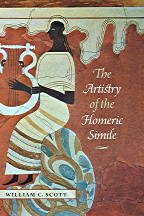
William C. Scott, The Artistry of the Homeric Simile. Hanover, N.H.: Dartmouth College Library and Dartmouth College Press; Published by University Press of New England, 2009. Pp. viii, 267.
- ISBN 9781584657972.
- $45.00 (pb).
Recension par Christodoulos Zekas dans Bryn Mawr Classical Review 2010.10.67.
Extraits en ligne sur le site de l'éditeur.
Présentation de l'éditeur:
The similes in Homer are treasure troves. They describe scenes of Greek life that are not presented in their simplest form anywhere else: landscapes and seascapes, storms and calm weather, fighting among animals, aspects of civic life such as settlements of disputes, athletic contests, horse races, community entertainment, women carrying on their daily lives and men running their farms and orchards. But the similes also show Homer dealing with his tradition. They are additions to the narrative showing how the Greeks found and developed parallels between two scenes, each of which elucidated and interpreted the other, and then expressed those scenes in effective poetic language.
Table des matières:
Preface (vii)
Chapter One
Similes, the Shield of Achilles, and Other Digressions (1)
The Usefulness of Book Divisions (10)
Chapter Two
The Simileme: The Background of the Homeric Simile (14)
The Oral Nature of Homeric Verse (14)
The Simileme (18)
Homer and His Audience (31)
Simile and Simileme (37)
Chapter Three
Homer's Use of Similes to Delineate Character and Plot (42)
Iliad, Book 2: Ironic Characterization (43)
The Similes of Book 2 (44)
The Role of Similes in Book 2 (59)
Iliad, Books 21 and 22: Similes to Show a Thematic Contrast (65)
Iliad, Book 11: Similes to Mark a Shifting Scene (78)
Conclusion (89)
Chapter Four
Similes to Delineate a Narrative Theme (94)
Iliad, Book 12: Direct Focus on a Single Theme (94)
Iliad, Book 5: The Use of Parallel Similemes to Create a Unified Theme (102)
Odyssey, Book 22: Similes to Interpret Typical Actions (112)
Odyssey, Book 5: Thematic Similes (118)
Conclusion (126)
Chapter Five
Problem Books (130)
Iliad, Book 13: The Ordering of Conscious Chaos (130)
Iliad, Book 17: Similes as Guides through a Series of Type Scenes (145)
Iliad, Book 16: Similes for Complexity (155)
Conclusion (171)
Chapter Six
The Creative Poet and the Co-creating Audience (174)
The Simile within the Narrative (174)
The Poet's Choices in Forming the Individual Simile (181)
The Creative Moment: Poet and Audience (185)
Charts of Similemes: The Basic Motifs (189)
Notes (207)
Bibliography (247)
Index (257)